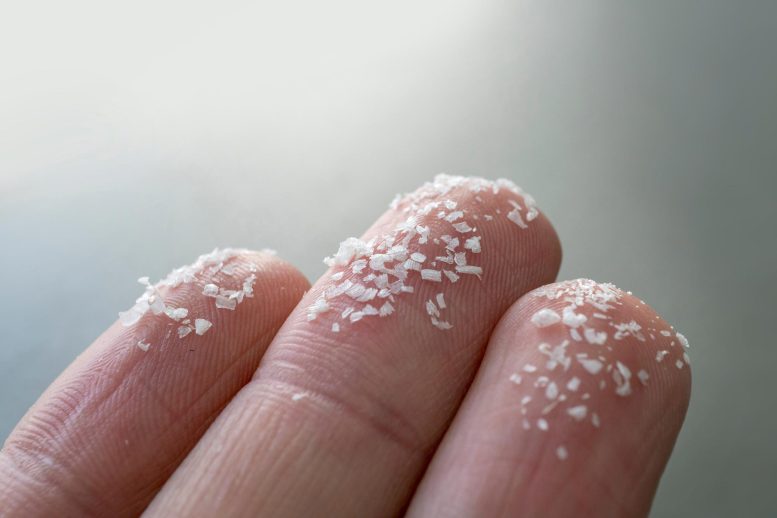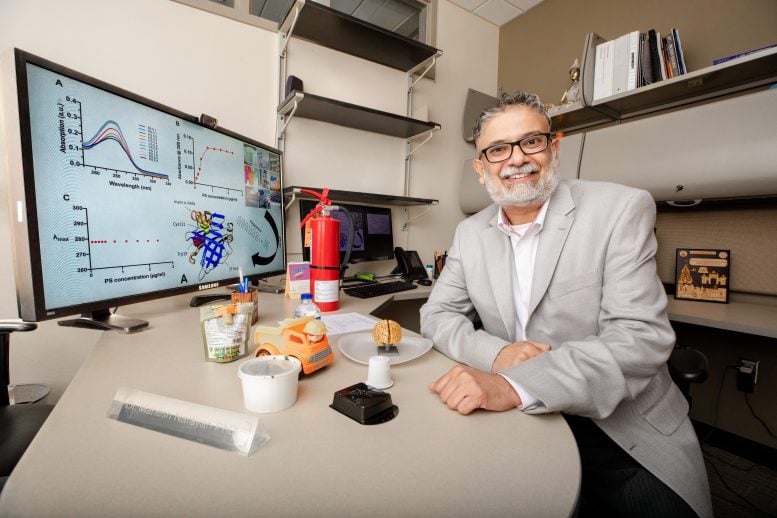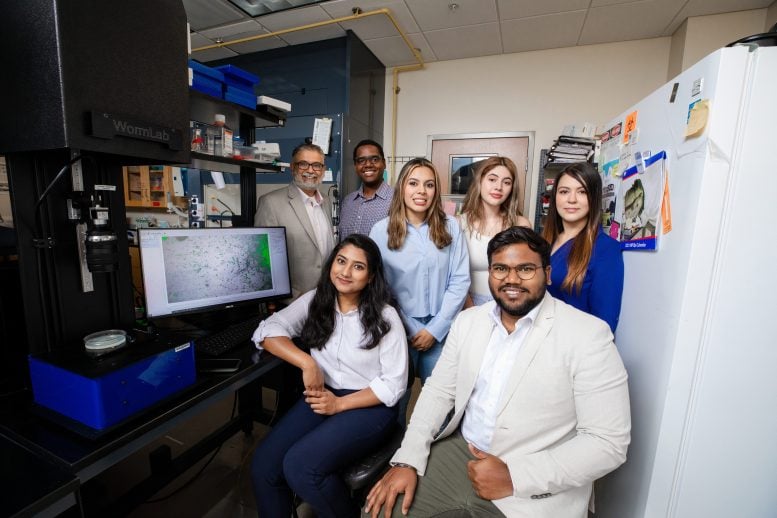
UTEP study reveals that both nanoplastics and forever chemicals modify crucial proteins in breast milk and infant formulas.
Researchers at The University of Texas at El Paso have achieved important advancements in the study of nanoplastics and per- and polyfluoroalkyl substances (PFAS), also referred to as forever chemicals. Their research demonstrates how these compounds can modify the structure and function of biomolecules. Specifically, the team found that these substances can change proteins present in human breast milk and infant formulas, which could potentially lead to developmental problems later on.
Nanoplastics and forever chemicals are manmade compounds present throughout the environment; a series of recent studies have linked them to numerous negative health outcomes. While nanoplastics originate primarily as a result of the degradation of larger plastic materials, like water bottles and food packaging, forever chemicals are found in various products like cookware and clothing.
The UTEP research team focused on the compounds’ impact on three proteins critical to human development and function: beta-lactoglobulin, alpha-lactalbumin, and myoglobin. Their findings, which provide an atomic-level insight into the detrimental effects of nanoplastics and PFAS on human health, are described in two recent articles in the Journal of the American Chemical Society and ACS Applied Materials and Interfaces.

“By understanding the molecular mechanisms of how nanoplastics and forever chemicals disrupt cellular functions, scientists can develop safer alternatives to these materials,” said Mahesh Narayan, Ph.D., a professor, fellow of the Royal Society of Chemistry and chief of the Division of Biochemistry in UTEP’s Department of Chemistry and Biochemistry, who oversaw the two studies. “The insights gained from this research have far-reaching implications.”
Narayan said that, most importantly, their research revealed that nanoplastics and PFAS completely “dissolved” a region of proteins known as the alpha helix, converting them into structures called beta sheets.
“We weren’t expecting them all to have this similar impact on the alpha helix,” Narayan said. “It was a complete coincidence.” The team observed that this alteration also occurs in amyloid proteins, which can cause neurodegeneration and neurotoxic outcomes if the synthetic chemicals reach the brain.
Additional key findings of the studies are described below.
Milk Protein: Beta-Lactoglobulin (BLG)
BLG is a protein found in the milk of sheep and cows and is commonly used as an ingredient in infant formula. The protein binds to retinol (vitamin A) and fatty acids and is crucial for vision and brain development in infants.
The research team discovered that the binding efficiency of BLG to retinol and fatty acids decreases upon exposure to nanoplastics and PFAS. This decrease, modeled by Lela Vukovic, Ph.D., associate professor in the Department of Chemistry and Biochemistry, can lead to significant developmental issues in neonatal infants, the team said.
Additionally, for the first time ever, the team observed that PFAS binds to the milk protein, turning it into a carrier for these compounds.

Human Breast Milk: Alpha-Lactalbumin
Alpha-lactalbumin is found in human breast milk, participates in lactose synthesis, and is ingested by infants to help meet nutritional needs. UTEP researchers found that nanoplastics and PFAS corrupt the structure of alpha-lactalbumin protein, thereby potentially compromising lactose formation. The team said the disruption can lead to downstream developmental defects in neonatal infants, such as compromised immunity and reduced mineral absorption.
Oxygen Storage: Myoglobin
Myoglobin, found in the blood and muscle tissue of most mammals, is crucial for storing oxygen. The UTEP research team found that nanoplastics and PFAS compromise the functionality of the myoglobin protein, disrupting its ability to store oxygen. This disruption could lead to health issues such as breathlessness and anemia.
Additional experiments by the team demonstrated that exposure to nanoplastics impairs locomotion in worms, with effects comparable to paraquat — an herbicide that has been tied to causing Parkinson’s disease.
“This work has the potential to significantly impact public health and environmental policies, highlighting the vital role of scientific research in addressing global challenges,” said Robert Kirken, Ph.D., dean of the College of Science. “I am proud of the groundbreaking research conducted by Dr. Narayan, Dr. Vukovic, and their teams. Their innovative approach to understanding how these manmade materials disrupt biomolecular functions is a prime example of the transformative work UTEP researchers do on a regular basis.”
Narayan and his research team plan to continue their studies and investigate the effects of other plastics and PFAS compounds.
References:
“An Atomic and Molecular Insight into How PFOA Reduces α-Helicity, Compromises Substrate Binding, and Creates Binding Pockets in a Model Globular Protein” by Anju Yadav, Lela Vuković and Mahesh Narayan, 24 April 2024, Journal of the American Chemical Society.
DOI: 10.1021/jacs.4c02934
“Interfacial Interactions between Nanoplastics and Biological Systems: toward an Atomic and Molecular Understanding of Plastics-Driven Biological Dyshomeostasis” by Afroz Karim, Anju Yadav, Ummy Habiba Sweety, Jyotish Kumar, Sofia A. Delgado, Jose A. Hernandez, Jason C. White, Lela Vukovic and Mahesh Narayan, 9 May 2024, ACS Applied Materials & Interfaces.
DOI: 10.1021/acsami.4c03008
4 Comments
Isn’t that already a common knowledge?
For sure, but the more research we preform can help in two ways: 1. helping us understand exactly what it disrupts and what to expect now in our personal lives and 2. giving us more potential ammo for legislators to actually regulate the product(s)/chemical(s). Even if we don’t reach the second point because if the government cared we wouldn’t be in this situation, the only way to potentially get there is to have proof on proof.
To me or looks like they’re trying to develop some new drug to push on us, under the guise of “coping against chemicals”. Another tech shortcut for the masses.
There are so many chemicals added to our food products that make the food potentially lethal. These things won’t show up i an autopsy unless you are looking for them or maybe not at all. Sucralose is in the high protein drinks like Ensure, and all the flavors of Ensure include Sucralose except the Ensure Plus Strawberry flavored one. Makes me wonder why it’s necessary to add this “ingredient”? Sucralose destroys the good bacteria i your digestive system faster than your body can replenish it, and it destroys your bones, as well. While in a major hospital after having a triple (heart) by pass, I was offered this drink from the hospital menu. Little did I know that it was making me weaker than adding cyanide to my food. After my recovery, at home, I started to drink made by the Talking Rain Beverage Company in Washington State, Also “sweetened”with Sucralose. It was appetizing, refreshing and seemed to quench me thirst, until I found myself drinking more that 12 bottles a day to actually quench my thirst because, little did I know, it was killing off my colon. I finally formulated a menu that I could eat more safely. There are so many artificial sweeteners that are added to our foods, including frozen dinners, soups, packaged baked goods and the lot, that my choices are very limited. If you are at all concerns about your health and life longevity, check out what you are eating and let me know what you have found. American’s are being poisoned. Sounds drastic, but since the Covid scare, you should be more aware of the lies perpetrated in the name osf GOOD HEALTH, BETTER HEALTH, BALANCED NURITION, ETC.